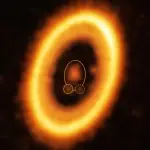This marks a significant milestone for the astronomical community, as it marks the the first-time scientists have observed this phenomenon unfolding in real-time.
“Our research is like solving a puzzle by gathering all possible evidence,” said Ping Chen, a researcher at the Weizmann Institute of Science in Israel, and lead author of a study published in Nature.
“All these elements aligning lead to the revelation.”
The story starts with the detection of a new bright object by a South African amateur astronomer, Berto Monard. He stumbled upon the object – named SN 2022jli – in the spiral arm of the NGC 157 galaxy, situated approximately 76 million light-years away.
The emergence of a new bright object in the sky hints at a supernova, prompting astronomers to quickly direct their telescopes towards it, utilizing additional surveys to corroborate its location and other pertinent details. Supernovas pose a challenge for study due to their unpredictability and fleeting nature.
A supernova is the violent explosion of a star when it dies. They collapse under their own gravity, and the resulting explosion can sometimes be as bright as entire galaxies, until they dim once again.
Scientists strongly speculate that black holes and neutron stars – both extraordinarily dense entities born from stellar collapse – are the subsequent stages. However, despite witnessing supernova explosions in the past, the transition from supernovas to a compact object has never been directly observed.
SN 2022jli defied conventional space rules. Initially luminous, it gradually dimmed before experiencing a resurgence in brightness a month post-discovery, followed by weird undulations occurring roughly every 12 days for the next 200 days.
“In SN 2022jli’s data we see a repeating sequence of brightening and fading,” says Thomas Moore, a from Queen’s University Belfast, who’s study of the supernova was published last year in the Astrophysical Journal.
“This is the first time that repeated periodic oscillations, over many cycles, have been detected in a supernova light curve.”
Both research teams posit that a secondary star – somehow surviving the supernova explosion – is the culprit, facilitating the ‘visibility’ of the compact entity.
The teams hypothesize that the black hole or neutron star would steal hydrogen from the ‘puffy’ atmosphere of its companion. This process of stealing, known as accretion, emits copious amounts of energy in waves, accounting for the oscillations detected by the researchers.
“The unprecedented properties of SN 2022jli tell that whatever happens in the system should be a rare phenomenon, which might be explained by the rarity of a bound binary system surviving a supernova explosion,” the researchers write in their Nature paper.
“SN 2022jli establishes a direct correlation between the supernova explosion and the genesis of a compact entity.”


